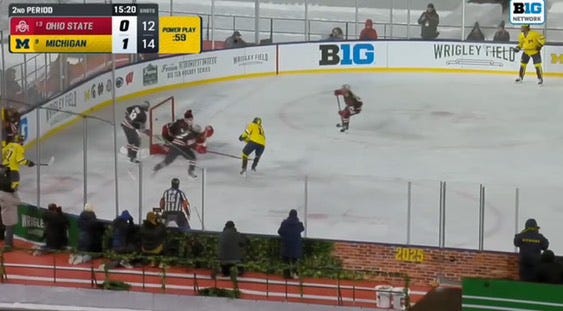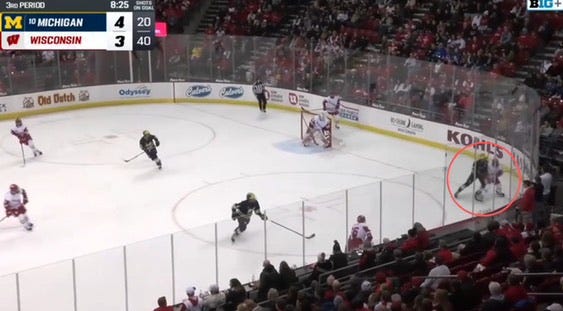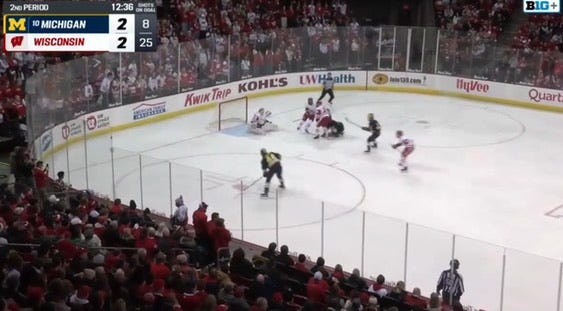Skating:
- Straight Line Skating:
William Horcoff’s straight line skating is serviceable at the level he plays at, his skating as a whole is a major swing skill in his overall projection. His stride mechanics need significant refinement. His top-end speed is ok in open ice, but it’s more a reflection of his size and athleticism than efficient skating form. Horcoff’s stride lacks full extension, which reduces his power output. During push-off, he frequently kicks his heel up, a clear indicator that he’s not driving through the full range of motion. Horcoff’s incomplete extension cuts into his overall stride length, forcing him to take more steps to cover the same distance. This inefficiency limits his ability to separate from defenders or maintain consistent speed. He’s had a problem with this dating back to last year and he’s improved slightly since then in this aspect. In 2024, his strides were even shorter and choppier. This limits his power generation and forces him to take more strides to cover the same distance. Another one of Horcoff’s most noticeable mechanical issues is the lack of ankle flexion on his lead leg. Instead of driving his shin forward, his skate remains more upright, decreasing his ability to generate power in the first half of his stride and stability. Without flexion, Horcoff struggles to maximize his push-off force and often glides through his stride instead of driving with pace. This is something that has affected him for years now. Horcoff’s knee bend is inconsistent. When in motion, he tends to skate more upright, which limits his ability to generate force and stay balanced through contact. This upright posture also makes it harder for him to accelerate quickly or transition efficiently on directional changes.
Horcoff had a top tracked speed in the 10th percentile of all players I have tracked in my 4 year dataset in the 3 NCAA games I tracked of him this season. I should mention that my dataset may be a skewed sample due to my tendency to want to track faster players and the fact that Horcoff has a limited amount of “speed bursts” through the way he plays the game. With that being said though, Horcoff’s skating mechanics hold back his overall effectiveness. His lack of full extension, limited ankle flexion, and upright stance reduce his power and agility. While he shows flashes, refining his stride efficiency will be key to unlocking his full potential. With improvements in stride length, ankle flexion, and knee bend, he could significantly enhance his top speed and speed creation, making him a more projectable NHL prospect.
Lateral Skating:
William Horcoff’s lateral skating is an area of concern, even more so than his straight line skating. While he demonstrates a higher work rate in his movements in 2025, his ability to generate acceleration and control his edges in crossovers has not progressed as much as expected. In 2024, he struggled to create acceleration from his inside edges, often failing to drive through his push-offs. His weight distribution was inconsistent, leading to inefficient lateral movement. In 2025, there is some visible improvement in his ability to rotate his hips and commit to crossovers, but the execution remains problematic. His recovery foot often lags slightly behind, reducing the efficiency of his lateral transition. Additionally, the inside leg remains too stiff during push-off, preventing him from generating more power in his crossover sequences. While his outside edges look more stable, he still lacks explosiveness in directional changes. Horcoff’s posture while handling has stayed the same. Additionally, his knees do not consistently track over his toes, leading to moments where his center of mass shifts too high, reducing stability. Despite his overall speed increasing in 2025, his ability to build and maintain speed through changes in direction has not seen significant improvement. His stride extension in crossovers remains incomplete, limiting his ability to gain separation from defenders when changing lanes. To take his skating to the next level, Horcoff needs to refine several aspects of his technique. He must drive through his inside edges with more force to increase his lateral acceleration and improve his crossover recovery to eliminate the slight lag that disrupts his transitions. His posture also requires attention, particularly in keeping his knees over his toes and reducing unnecessary upper-body lean to maintain better balance. Furthermore, he must develop more explosive directional changes, generating power with each crossover rather than relying on frequent but less effective movements.
While Horcoff has a solid foundation, his lateral skating still presents a notable limitation in his overall game, more so than his straight line skating. His work rate in 2025 has increased, but his ability to generate speed through his edges remains a concern. With refinement in his mechanics, particularly in edge engagement and acceleration, he could become more effective in lateral transitions. Without those adjustments, however, his ability to create space and accelerate will remain a challenge at higher levels of play.
Skills:
Playmaking
As a playmaker, Horcoff demonstrates strong vision and a willingness to facilitate offence, though there are notable areas for improvement. He ranks in the 75th percentile among Big 10 forwards in high-danger passes per 20 minutes (minimum 10 games played) and in the 83rd percentile in total passes per 20 minutes, which shows his ability to generate puck movement and high quality puck movement through him. His strength lies in his capacity to recognize passing lanes quickly and execute plays under physical pressure, making him a valuable and translatable distributor in the offensive zone.
Horcoff’s passing effectively in transition. He consistently looks to push the pace and finds teammates in stride, creating controlled zone entries. Horcoff ranks in the 65th percentile among BIG 10 forwards in zone entries via pass per 20. His ability to adjust his passing angles and use deception when moving through the neutral zone makes him a threat to break down defensive structures. In the offensive zone, during sustained sequences of pressure, Horcoff’s playmaking is at its best. He excels at distributing from the half-wall, where he has more time to scan the ice and manipulate defenders. He uses his size to shield the puck and extend plays under pressure. His ability to absorb contact and maintain possession allows him to execute passes in tight spaces, a crucial skill that enhances his overall playmaking impact.
One of Horcoff’s biggest assets is his vision. He frequently anticipates plays before they develop, allowing him to connect on difficult passes that open up high-danger scoring chances. His patience with the puck is commendable, but he would benefit from quicker decision-making in certain situations to reduce turnovers. While he occasionally forces plays in congested areas, his ability to find open teammates outweighs these instances.
Defensive Awareness & Disruption
William Horcoff’s defensive game is already built on strong habits that make his play translatable to higher levels. His 6-foot-4 frame gives him a natural advantage in closing down lanes and sealing off opponents along the boards. He consistently uses his reach effectively, poking pucks away and guiding attackers into less dangerous areas. His stick positioning is sharp, often protecting the middle and angling opponents into the walls. Horcoff also flashes physicality, initiating early contact to disrupt plays and assert his presence.
Despite these strengths, his defensive metrics reveal areas for growth. Among Big 10 forwards who have played at least 10 games, Horcoff ranks in only the 14th percentile in takeaways per game. He also sits near the bottom in puck battles—95th out of 98 forwards in battles per game and 97th/98 in win rate, winning roughly 37% of his battles. This highlights his current struggles to consistently win possession despite his frame. Additionally, his expected goals against per 20 minutes is -0.43 relative to his team, and his EV xGF% is -7.4% relative to his team making him one of the worst on the roster in these metrics. This indicates that while he shows flashes of defensive prowess, his overall on-ice impact still needs refinement. However, given his age and the physical development still ahead of him, there is reason to believe these numbers will improve as he adds strength to his frame and refines his technique.
The flashes of high-end defensive play are evident. He shows sharp recognition of passing lanes, disrupts attacks with timely stick work, and often clogs the neutral zone with smart positioning. If Horcoff can improve his stability and power, his defensive disruption will become a consistent strength, giving him a real shot at carving out a reliable bottom-six NHL role.
Physicality
At 6-foot-4, Horcoff can naturally play a heavy game, using his size to lean on opponents, seal off lanes, and wear down defenders. He thrives along the boards, where he has shown to guide attackers into the walls and uses his reach to pry pucks loose. Around the net, he plants himself effectively, tying up defenders and creating chaos in the crease. When given the chance, Horcoff doesn’t hesitate to finish his checks, often initiating contact early to disrupt plays.
Among Big 10 forwards with at least 10 games played, he ranks in the 70th percentile in hits per 20 minutes. This shows he actively seeks out contact and is willing to engage. On the forecheck, despite his skating limitations, he uses his frame to punish defenders, making life difficult for them on retrievals. Off the cycle, he shields the puck well, creating space through body positioning rather than raw speed.
While his physical game is already a strength, there’s still room for growth. He could better use his frame to drive through opponents rather than simply contain them. As he adds strength and refines his skating, Horcoff’s physicality will become even more effective, giving him a clear path to a bottom-six NHL role built around toughness and disruption.
Support Play
William Horcoff’s support play is one of the most effective parts of his game. His value comes from smart positional timing, well-executed routes, and sharp reads rather than driving play himself. He consistently positions himself in soft spots, making himself an outlet option or a trailing threat on the rush. His ability to adjust his speed and angle of attack makes him highly effective at linking plays and creating secondary scoring opportunities. Whether off the cycle or in transition, he consistently finds space and presents himself as a reliable target.
Statistically, Horcoff’s off-puck impact is reflected in his shot generation. Among Big 10 forwards with at least 10 games played, he ranks 31st out of 98 in counterattack shots per 20 minutes, showing how frequently he becomes a shooting option off the rush. In the offensive zone, he ranks 13th in cycle shots per 20, highlighting his knack for slipping into scoring areas during sustained pressure and leveraging his physical tools. However, his overall pick involvement is lower. He sits 63rd in puck touches per game and 72nd in average time per puck touch, indicating that his chance creation relies more on smart movement and timing than direct play-driving ability.
Horcoff’s support instincts are most evident in transition. He regularly trails the play or times his entries into the zone, giving puck carriers a reliable secondary option. His ability to read defensive gaps allows him to arrive in high-danger areas, making him a sneaky scoring threat. On the rush, he often starts in a supporting role but adjusts quickly, slipping into soft ice behind the defense or driving into the middle to create an option. When he receives the puck, he makes quick, decisive plays—either by moving it immediately or by firing catch-and-release shots. Off the cycle, Horcoff’s spatial awareness stands out. He frequently shifts into passing lanes, arriving as a late option or floating into open areas to give teammates a target. He also makes sharp give-and-go plays, keeping the puck moving and forcing defenders to reset. His ability to delay along the wall and wait for a teammate to jump into space adds to his effectiveness as a connector.
While Horcoff isn’t a high-volume puck handler, his combination of support instincts, off-puck timing, and quick decision-making makes him a reliable play facilitator. His strong routes and ability to find quiet ice allow him to consistently generate chances, even without being a primary puck carrier.
Perception:
Tactical Recognitions
The Michigan Wolverines have had a decent but underwhelming 2024-25 season, finishing with an 18-15-3 record, which, while above .500, doesn't quite meet expectations. The team ranks 6th out of 7 Big 10 teams in expected goals per game and scoring chances per game, showing a lack of offensive dynamism despite having a talented roster. Under the guidance of head coach Brandon Naurato, Michigan has focused on a fast-paced, aggressive and physical game, but at times, they have lacked the consistency to generate quality chances.
Horcoff has spent much of the season in a bottom-six role, averaging 14:25 per game, but his usage has seen a fair share of power play opportunities, playing 2:50 of Power Play time per game. This has added to his production. 45% of his primary points this season have come from the power play, on the powerplay Horcoff's role is clear: he’s the net-front presence, aiming to create chaos around the crease and capitalize on rebounds or tip-ins. His performance on the power play has been effective, though he is not known for his playmaking abilities or offensive creativity. While Michigan's tactics under Naurato have been in the past, focused on speed, Horcoff’s game lacks the high-end speed and puck skills required to thrive in a primary offensive role. However, his ability to make an impact in front of the net, combined with his physical style of play, provides Michigan with a reliable role player who is capable of contributing in specific game situations.
Speed Perception
William Horcoff’s approach to speed in game is defined more by perception and manipulation than outright pace. While his skating lacks acceleration and agility, he compensates with a strong understanding of timing and relying on his athletic traits. Horcoff frequently controls his speed to extend passing windows and shift defensive coverage, using delays along the boards or well-timed puck movements to create space. His ability to adjust routes and maintain offensive positioning allows him to stay involved in the play, even when his overall mobility is a limitation. In transition, he waits for pressure to move before making plays, using subtle changes in tempo to open lanes. However, his lack of consistent pace can also hinder his ability to force defenders into movement, occasionally leaving him stuck in slower sequences. While not a speedster, Horcoff’s awareness of pace shifts and his ability to exploit defensive positioning add an intriguing layer to his game.
William Horcoff’s game is defined by his strong playmaking instincts, physical presence, and ability to support offensive plays, but his effectiveness at the next level might be hindered by his skating. His lack of lateral agility and inefficient stride mechanics limit his ability to fully capitalize on his offensive vision and size. He has shown flashes of high-end passing ability in transition and off the cycle and net front, scoring skills but without improvements in his skating it will be hard for him to keep up when the game is faster.
As the son of a long tenured NHLer who played over 1000 games, Horcoff should know what it takes to be a pro and make it at the next level. He still has room to develop, and his potential as a middle-six supporting forward remains intact if he can make significant skating improvements. Given his blend of size, playmaking, and defensive potential, he is a worthwhile swing in the 3rd round range of this year’s draft. If his skating mechanics improve, he could emerge as a reliable two-way forward with secondary offensive upside. If not, he might still be able to make an impact but it might be limited to depth roles where his physical tools and smart support play can provide value.
Finlay Sherratt
March 2025
finlay.sherratt@gmail.com






















